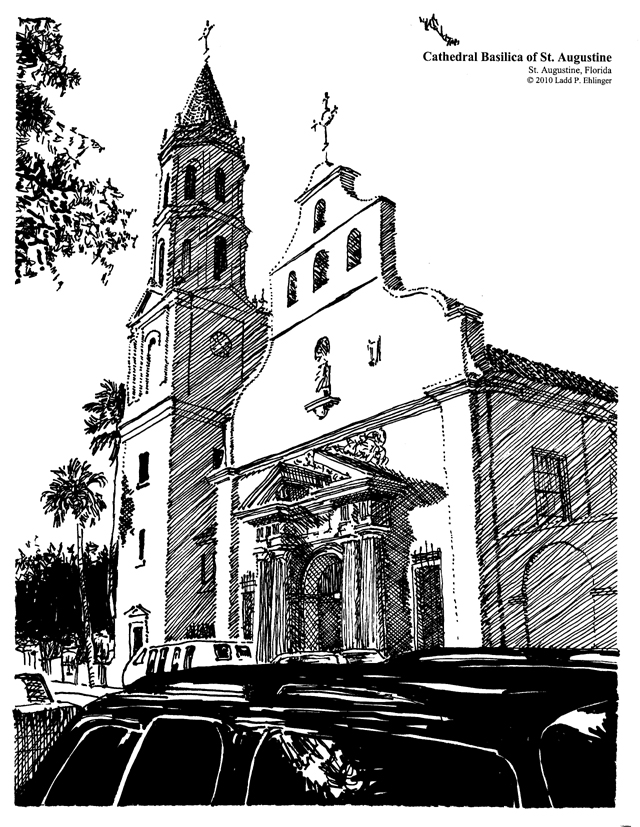
Projects Newsletters Personnel Contact

In 1565, the Spaniard Don Pedro Menéndez de Avilés sailed from the port of Cádíz, Spain with prospective Spanish settlers and sighted land on the east coast of Florida on August 28 in what is now known as Cape Canaveral. He went further north and landed on Sept. 8 in a natural harbor of the native Timuacan tribe and named it St. Augustine, because the 28th of August was the feast day of St. Augustine of Hippo. Menéndez was presented with a cross to kiss by Father López Mendoza Grajales as the hymn Te Deus Laudamus was sung upon coming ashore, after which a mass was celebrated. This was the beginning of the establishment of the oldest European settlement in North America, and the founding of the City of St. Augustine and the parish of the Cathedral Basilica of St. Augustine.
There were four Spanish Franciscan priests that came with Menéndez to evangelize and convert the natives, as well as minister to the settlers. The first church they established was in the southeast corner of the main plaza of St. Augustine, whereas the present day Cathedral is on the north side of the plaza in the center. The Franciscans also established missions to the north as far as St. Catherine’s Island, GA and to the west near Tallahassee.
Sir Francis Drake, the English privateer (pirate) pillaged and burned St. Augustine including this first church in 1586. Everything was rebuilt, but the need for more security prompted the construction of Castillo de San Marcos. This was a stone fortress authorized by the Spanish Crown to protect its northernmost flank, and was begun in 1672 and completed in 1695. In the war of Spanish succession, the English occupied the city but failed to take the fort after a 50 day siege. They then burned the town and left.
The English took over in 1763, when Florida was ceded to the them in the conclusion of the French and Indian War as part of the First Treaty of Paris. In the second Treaty of Paris in 1783, the independence of the U.S. was recognized and Florida was returned to Spain. Finally, in 1821 Spain ceded Florida to the U.S.
When the English governed between 1763 and 1783, a colony / plantation was started in New Smyrna, 60 miles south of St. Augustine, the English capital of East Florida. Dr. Andrew Turnbull recruited settlers from around the Mediterranean, mostly from Greece, Minorca, Corsica, and some from Turkey. In return for passage to Florida, settlers agreed to work for 5 years on the plantation. Dr. Turnbull reneged on most of these contracts and refused to release these people when their contracts had been fulfilled, also treating these indentured workers cruelly and abusively, sometimes to the degree of manslaughter. There were two revolts, the second of which was successful due to the need of the English for able bodied men for military service during the American Revolution. The colony collapsed, the indentured workers moved to St. Augustine, and being Catholic, created the need for a larger Parish worship center. The Parish was elevated to a Diocese and the Cathedral was built in 1786 per a directive of the Spanish crown.
In 1887 a fire occurred in the adjacent St. Augustine Hotel which spread to the Cathedral, severely damaging it. The suibsequent reconstruction added the bell tower and transept wings. The basic plan of the Cathedral is Basilican, that is with a long simple Nave straight from the Narthex (Entry) to the Apse where the altar is located. The walls were built of coquina stone, a locally available very soft stone formed by deposition of marine animals, similar to limestone though not subjected to any overburden pressures. Coquina hardens considerably when exposed to air after quarrying, but still has to be clad with stucco to protect it from the weather. The superstructure consists of wooden timber trusses and decking, covered with tile shingles. The main facade is exemplary of Spanish Colonial architecture with large, plain wall surfaces embellished with decorative porches and openings. This a very mild expression of Churrigueresque architecture.
Ladd Ehlinger AIA